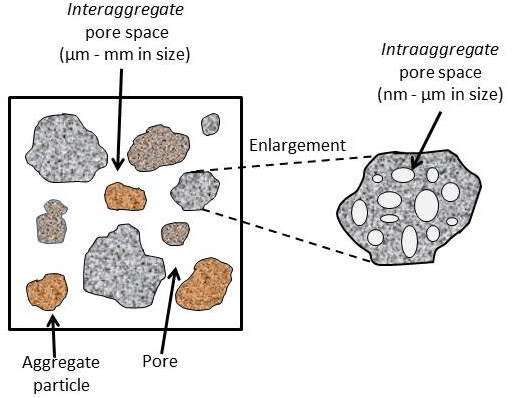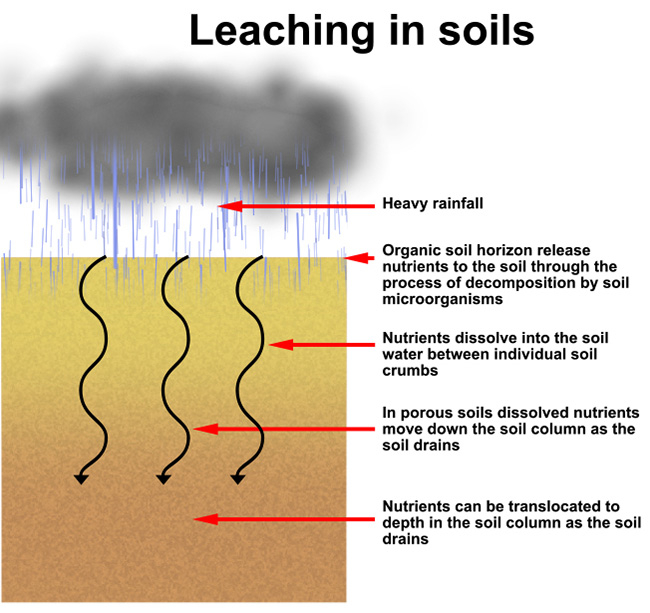토양의 수분 함량 측정
English
Share
Overview
출처: 이안 페퍼 박사와 찰스 게르바 박사의 연구소 – 애리조나 대학교
시연 저자: 브래들리 슈미츠
토양은 일반적으로 “토양 수분 함량”으로 표현 될 수있는 물의 유한 한양을 포함합니다. 이 습기는 토양 응집체(골간 모공 공간) 및 토양 골재(골재 공간) 내에 있는 공공 공간 내에존재한다(도 1). 일반적으로이 모공 공간은 공기 및 / 또는 물에 의해 점유된다. 모든 모공이 공기에 의해 점유되면 토양은 완전히 건조합니다. 모든 모공이 물로 채워지면 토양은 포화 상태라고 합니다.

그림 1. 토양의 모공 공간.
Principles
실외 자연 환경에서는 강우량이나 식물의 고의적인 관개를 통해 토양에 물이 추가됩니다. 두 경우 모두, 더 많은 모공이 공기의 비용으로 물로 채워짐에 따라 토양 수분이 증가합니다. 모든 모공이 물로 채워지면, 비가 오거나 관개가 멈출 때까지 연속 적인 토양 모공을 통해 여분의 물이 아래로 침출됩니다(그림 2). 침출은 모공 내의 물 필름이 중력의 힘에 대한 토양 콜로이드의 표면 장력에 의해 유지 될 때까지 계속됩니다. 이러한 상황은 토양 수분에 대하여 토양이 “필드 용량”에 있는 것으로 지칭된다. 현장 용량의 토양에는 토양 수분 필름으로 둘러싸인 공기로 부분적으로 채워진 모공이 있습니다. 일반적으로 현장 용량의 토양은 공기와 물을 모두 사용할 수 있기 때문에 식물 성장과 호기성 토양 미생물에 최적입니다. 대조적으로, 포화 토양은 혐기성 미생물을 자극하면서 식물을 죽이고 호기성 토양 미생물을 억제 할 수있는 물로 막힌 혐기성 조건을 생성합니다.

그림 2. 토양에서 침출 영양소.
비커와 같은 용기 내에서 습한 토양 샘플을 고려하십시오. 습한 토양의 무게는 건조한 토양 입자의 무게와 토양 내의 물의 무게로 구성됩니다. 토양에 더 많은 물이 추가되면 토양의 젖은 무게가 증가합니다. 시료 내의 토양 입자의 건조 중량은 건조 중량인 1중량, 즉고정된다. 대조적으로, 토양에 추가되는 물의 양에 따라 젖은 무게의 무한한 수가 있습니다. 이 때문에 토양을 실험할 때, 토양의 수분 함량은 일반적으로 건조 중량 기준으로 표현되며, 이는 건조 중량이 시간이 지남에 따라 일정하기 때문에, 습기나 습한 무게는 시간이 지남에 따라 변할 수 있다. 토양의 영양 분과 와 같은 실험의 결과를 표현할 때, 건식 중량 기준의 사용은 최종 결과의 표준화를 제공한다.
Procedure
Results
Calculate the soil moisture content for each of the replicate samples using the following equation:
% moisture content (MC) = 
(dry wt. basis)
Example Calculations:
M = 102 g
D = 90 g
∴ % MC = 
MC = 13.3%
With the addition of 5 g of water, new M = 107 and D still equals 90
∴ % MC = 
New MC = 18.9%
Applications and Summary
Knowledge of the moisture content of a soil on a dry weight basis is useful in a number of ways. For example, if the experiments are conducted with soil that should be amended with a known concentration of ammonium fertilizer (for example 50 μg/g), then the moisture content on a dry weight basis must be determined. If the calculation was completed on a wet weight basis, the amount of fertilizer to be added would depend on the moisture content (and therefore the moist weight) of the soil sample. Likewise, if potted plants are considered, the moisture content must be known in order to make sure that the soil isn’t too dry (not enough moisture for plant growth) or too wet (waterlogged and anaerobic). In a field situation, knowledge of the soil moisture content can prevent excess irrigation and leaching of soil nutrients.
Transcript
The amount of water held in soil is an important component of biological and ecological processes, and is used in applications such as farming, erosion prevention, flood control, and drought prediction.
Soils typically contain a finite amount of water, which can be expressed as the soil moisture content. Moisture exists in soil within the pore spaces between soil aggregates, called inter-aggregate pore space, and within pores in the soil aggregates themselves, called intra-aggregate pore space. If the pore space is occupied entirely by air, the soil is completely dry. If all of the pores are filled with water, the soil is saturated.
The measurement of the amount of water held within the soil, or the soil moisture content, is essential to the understanding of soil characteristics and the types of plants and microorganisms that reside in it.
This video will introduce the basics of soil moisture content, and demonstrate the procedure for determining moisture content in the laboratory.
In outdoor environments, water is added to soil naturally through rainfall or deliberately with the irrigation of plants. As the pores in the soil become filled with water at the expense of air, the soil moisture increases. When all of the pores are filled with water, the soil is saturated. If the soil at the surface is saturated, excess water will leach downward through pores into deeper soil. Leaching continues until there is not enough water to saturate all of the pore space. At this point pores contain some air and thin films of moisture. The water films within the pores are held by the surface tension of soil colloids, thus water stops leaching.
After leaching stops, and excess water has drained from the soil, the soil is described as being at field capacity. Soil at field capacity has pores that are partially filled with air, surrounded by films of moisture. Soil at field capacity is optimal for plant growth and aerobic soil microorganisms, since both air and water are available. In contrast, saturated soil, where all pores are filled with water, will create an anaerobic environment that can kill plants and suppress aerobic soil microbes.
The mass of moist soil consists of the mass of the dry soil particles, plus the mass of the water within the soil. The dry mass of the soil particles is fixed, whereas the amount of water within moist soil can vary. Therefore, moisture content is calculated on a dry basis, rather than a total mass basis, to ensure consistency. The moisture content of soil is described as the ratio of the mass of water held in the soil to the dry soil. The mass of water is determined by the difference before and after drying the soil.
The following experiment will demonstrate how to measure soil moisture content in the laboratory using these principles.
To begin, collect soil samples and transfer them into the laboratory. Samples of soil can be collected in the field using a soil auger, or a trowel. Use of a soil auger allows for the soil to be sampled to specific depths. Transfer them into the laboratory. Weigh two aluminum dishes, and accurately record the weight of each dish. Aliquot approximately 20 g of the moist soil into each aluminum dish, then reweigh the dish. Subtract the weight of the empty dish from the full dish to acquire the moist soil weight.
Next, dry the soil overnight in an oven set to 105 °C. On the next day, carefully remove the soil samples from the oven using tongs. Place the soil samples on the bench top to cool. When the dry soil samples are cool, reweigh them and record the total weight. Subtract the weight of the aluminum dish, and record the dry soil weight.
Calculate the moisture content of the soil by subtracting the weight of the dry soil from the weight of the moist soil, and then dividing by the weight of the dry soil.
Although the measurement is simple, it is important to determine soil moisture content in order to better understand soil characteristics.
Soil moisture content plays a large roll in environmental concerns, especially when considering soil runoff that may contain fertilizers and pesticides. In this example, soil runoff was analyzed using a simulated rainfall study in order to determine the retention of a compound in moist soil.
Soil, containing urea, was packed into soil boxes and assembled under a rainfall simulator. Soil runoff was collected, and the concentration of urea in the runoff water calculated. The amount of urea in the soil runoff was higher for soils that had higher moisture content, indicating that urea is better absorbed in drier soil, than in moist.
The fate of chemicals in soil can also be analyzed by direct pore water sampling, using a lysimeter, as shown in this example. In this experiment, lysimeters, or long metal tubing, were installed in soil with turf grass to analyze pore water in vegetative soil.
The pore water sampler was then installed, and water pumped from the lysimeter after applying chemicals to the soil. The collected water was then analyzed, and the concentration of applied chemicals correlated to soil depth and moisture content.
The results demonstrated that the concentration of the herbicide monosodium methyl arsenate, or MSMA, was the highest in the top 2 cm of soil.
You’ve just watched JoVE’s introduction to soil moisture content. You should now understand how to accurately measure soil moisture content in the laboratory. Thanks for watching!




